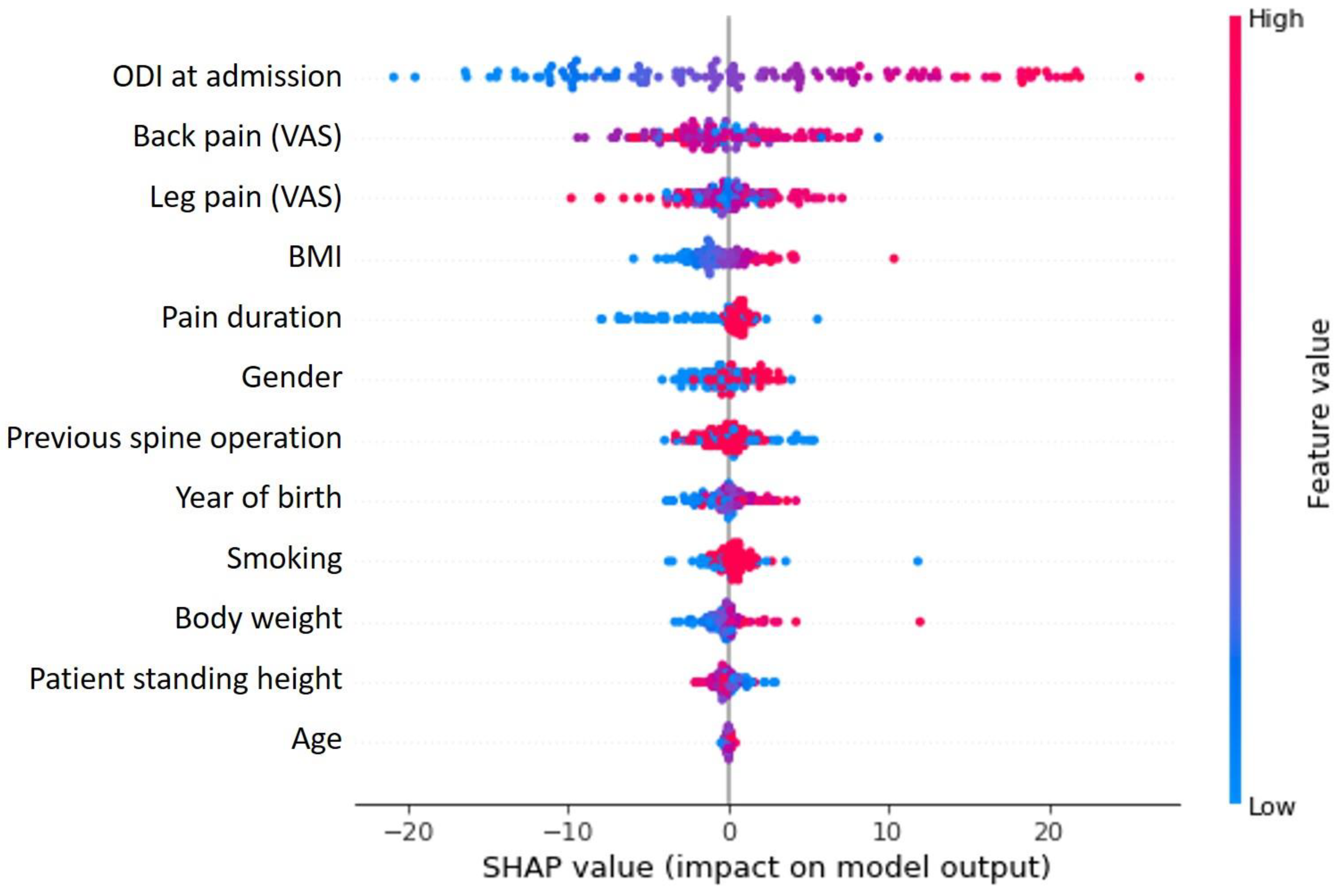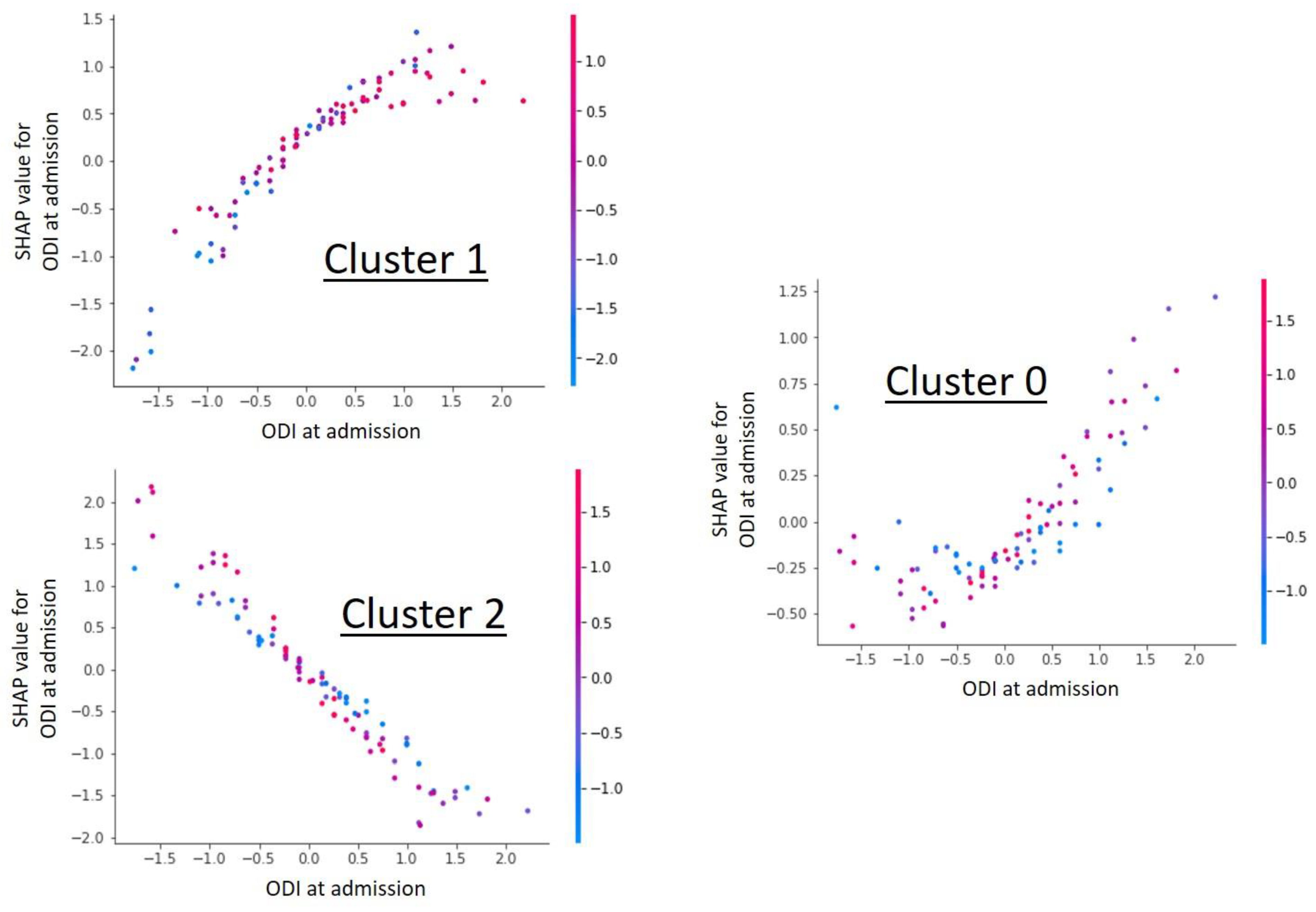Combined Artificial Intelligence Approaches Analyzing 1000 Conservative Patients with Back Pain—A Methodological Pathway to Predicting Treatment Efficacy and Diagnostic Groups
Abstract
:1. Introduction
2. Materials and Methods
2.1. Patient Population
2.2. Course of Standardised Conservative Therapy
2.3. Content and Structure of Database
2.4. Supervised Prediction of Treatment Efficiency
2.5. Cluster Analysis and Prediction
2.6. Combination of AI Approaches
- given ODI at admission;
- predicted change in ODI after therapy;
- predicted cluster group a patient belongs to.
3. Results
3.1. Prediction of Treatment Efficiency
3.2. Unsupervised Cluster Analysis with Supervised Cluster Prediction
3.3. Combined AI Approach for Predicting Groups of Diagnoses
4. Discussion
4.1. Prediction of Efficiancy of Conservative Treatment of Back Pain
4.2. Prediction of Cause of Back Pain
4.3. Weaknesses of the Presented Concept
4.4. Artificial Intelligence in Treatment of Back Pain
5. Conclusions
Author Contributions
Funding
Institutional Review Board Statement
Informed Consent Statement
Data Availability Statement
Acknowledgments
Conflicts of Interest
References
- Brinjikji, W.; Luetmer, P.H.; Comstock, B.; Bresnahan, B.W.; Chen, L.; Deyo, R.; Halabi, S.; Turner, J.; Avins, A.; James, K.; et al. Systematic literature review of imaging features of spinal degeneration in asymptomatic populations. Am. J. Neuroradiol. 2015, 36, 811–816. [Google Scholar] [CrossRef] [PubMed]
- Mallow, G.M.; Siyaji, Z.K.; Galbusera, F.; Espinoza-Orias, A.A.; Giers, M.; Lundberg, H.; Ames, C.; Karppinen, J.; Louie, P.K.; Phillips, F.M.; et al. Intelligence-Based Spine Care Model: A New Era of Research and Clinical Decision-Making. Glob. Spine J. 2021, 11, 135–145. [Google Scholar] [CrossRef] [PubMed]
- Harada, G.K.; Siyaji, Z.K.; Mallow, G.M.; Hornung, A.L.; Hassan, F.; Basques, B.A.; Mohammed, H.A.; Sayari, A.J.; Samartzis, D.; An, H.S. Artificial intelligence predicts disk re-herniation following lumbar microdiscectomy: Development of the “RAD” risk profile. Eur. Spine J. 2021. [Google Scholar] [CrossRef] [PubMed]
- Durand, W.M.; Lafage, R.; Hamilton, D.K.; Passias, P.G.; Kim, H.J.; Protopsaltis, T.; Lafage, V.; Smith, J.S.; Shaffrey, C.; Gupta, M.; et al. Artificial intelligence clustering of adult spinal deformity sagittal plane morphology predicts surgical characteristics, alignment, and outcomes. Eur. Spine J. 2021. [Google Scholar] [CrossRef] [PubMed]
- Kawchuk, G.N.; Guan, R.; Keen, C.; Hauer, B.; Kondrak, G. Using artificial intelligence algorithms to identify existing knowledge within the back pain literature. Eur. Spine J. 2020, 29, 1917–1924. [Google Scholar] [CrossRef]
- Khan, O.; Badhiwala, J.H.; Grasso, G.; Fehlings, M.G. Use of Machine Learning and Artificial Intelligence to Drive Personalized Medicine Approaches for Spine Care. World Neurosurg. 2020, 140, 512–518. [Google Scholar] [CrossRef]
- Mannion, A.; Junge, A.; Fairbank, J.; Dvorak, J.; Grob, D. Development of a German version of the Oswestry Disability Index. Part 1: Cross-cultural adaptation, reliability, and validity. Eur. Spine J. 2006, 15, 55–65. [Google Scholar] [CrossRef] [Green Version]
- Team, T. Pandas development Pandas-dev/pandas: Pandas. Zenodo 2020, 21, 1–9. [Google Scholar]
- Van Rossum, G.; Drake, F.L., Jr. Python reference manual. Centrum voor Wiskunde en Informatica. Amsterdam, The Netherlands. In Python Reference Manual; CWI (Centre for Mathematics and Computer Science): Amsterdam, The Netherlands, 1995. [Google Scholar]
- Hunter, J.D. Matplotlib: A 2D graphics environment. Comput. Sci. Eng. 2007, 9, 90–95. [Google Scholar] [CrossRef]
- Waskom, M.L. Seaborn: Statistical data visualization. J. Open Source Softw. 2021, 6, 3021. [Google Scholar] [CrossRef]
- Chollet, F.K. GitHub Repository. Available online: https://github.com/fchollet/keras-resources (accessed on 8 August 2021).
- Abadi, M.; Agarwal, A.; Barham, P.; Brevdo, E.; Chen, Z.; Citro, C.; Corrado, G.S.; Davis, A.; Dean, J.; Devin, M. Tensorflow: Large-scale machine learning on heterogeneous distributed systems. arXiv 2016, arXiv:1603.04467. [Google Scholar]
- McInnes, L.; Healy, J.; Melville, J. Umap: Uniform manifold approximation and projection for dimension reduction. arXiv 2018, arXiv:1802.03426. [Google Scholar]
- McInnes, L.; Healy, J.; Astels, S. hdbscan: Hierarchical density based clustering. J. Open Sour. Softw. 2017, 2, 205. [Google Scholar] [CrossRef]
- Lundberg, S.M.; Lee, S.-I. A unified approach to interpreting model predictions. In Proceedings of the 31st International Conference on Neural Information Processing Systems, (NIPS 2017), Long Beach, CA, USA, 4–9 December 2017; pp. 4768–4777. [Google Scholar]
- Mannion, A.; Junge, A.; Grob, D.; Dvorak, J.; Fairbank, J. Development of a German version of the Oswestry Disability Index. Part 2: Sensitivity to change after spinal surgery. Eur. Spine J. 2006, 15, 66–73. [Google Scholar] [CrossRef] [Green Version]
- Kedra, J.; Gossec, L. Big Data and artificial intelligence: Will they change our practice? Jt. Bone Spine 2020, 87, 107–109. [Google Scholar] [CrossRef]
- Wirries, A.; Geiger, F.; Hammad, A.; Oberkircher, L.; Blumcke, I.; Jabari, S. Artificial intelligence facilitates decision-making in the treatment of lumbar disc herniations. Eur. Spine J. 2020, 30, 2176–2184. [Google Scholar] [CrossRef]
- Galbusera, F.; Casaroli, G.; Bassani, T. Artificial intelligence and machine learning in spine research. JOR Spine 2019, 2, e1044. [Google Scholar] [CrossRef] [Green Version]
- Topol, E.J. High-performance medicine: The convergence of human and artificial intelligence. Nat. Med. 2019, 25, 44–56. [Google Scholar] [CrossRef]
- van Hooff, M.L.; Mannion, A.F.; Staub, L.P.; Ostelo, R.W.; Fairbank, J.C. Determination of the Oswestry Disability Index score equivalent to a “satisfactory symptom state” in patients undergoing surgery for degenerative disorders of the lumbar spine—A Spine Tango registry-based study. Spine J. 2016, 16, 1221–1230. [Google Scholar] [CrossRef] [PubMed]
- Osthus, H.; Cziske, R.; Jacobi, E. Cross-cultural adaptation of a German version of the Oswestry Disability Index and evaluation of its measurement properties. Spine (Phila Pa 1976) 2006, 31, E448–E453. [Google Scholar] [CrossRef] [PubMed]
- Ames, C.P.; Smith, J.S.; Pellisé, F.; Kelly, M.; Alanay, A.; Acaroglu, E.; Pérez-Grueso, F.J.S.; Kleinstück, F.; Obeid, I.; Vila-Casademunt, A. Artificial intelligence based hierarchical clustering of patient types and intervention categories in adult spinal deformity surgery: Towards a new classification scheme that predicts quality and value. Spine 2019, 44, 915–926. [Google Scholar] [CrossRef] [PubMed]




| Categorical Variables | Continuous Variables | Target Variable |
|---|---|---|
| Gender | Age | ODI at dismission |
| Pain duration > 3 month | Year of birth | |
| Smoking | BMI | |
| Previous spine operation | Back pain (VAS) | |
| Leg pain (VAS) | ||
| ODI at admission | ||
| Patient standing height |
| Fold | 1 | 2 | 3 | 4 | 5 | Mean | SD |
|---|---|---|---|---|---|---|---|
| Mean absolute error | 8.91 | 8.94 | 8.99 | 9.29 | 9.20 | 9.06 | 0.17 |
| Fold | 1 | 2 | 3 | 4 | 5 | Mean | SD |
|---|---|---|---|---|---|---|---|
| correct prediction | 89.4% | 80.6% | 92.3% | 91.5% | 93.9% | 89.54% | 5.25% |
| Cluster 0 | Cluster 1 | Cluster 2 | |||||||
|---|---|---|---|---|---|---|---|---|---|
| n | ODI Initial | Delta ODI | n | ODI Initial | Delta ODI | n | ODI Initial | Delta ODI | |
| osteoarthritis | 27 | 46.39 | 6.24 | 2 | 46.11 | 16.78 | 16 | 29.11 | 5.82 |
| 12.39 | 4.10 | 3.89 | 1.22 | 11.75 | 4.16 | ||||
| deformity | 14 | 30.90 | 3.34 | 1 | 26.00 | 19.33 | |||
| 5.96 | 3.04 | 0.00 | 0.00 | ||||||
| osteochondrosis | 74 | 45.67 | 7.53 | 6 | 22.93 | 3.44 | 22 | 27.94 | 5.93 |
| 15.84 | 8.07 | 11.45 | 4.99 | 11.62 | 6.63 | ||||
| olisthesis | 10 | 47.10 | 6.13 | 4 | 28.00 | 6.78 | |||
| 15.34 | 4.20 | 8.71 | 2.03 | ||||||
| other degenerative | 20 | 50.79 | 8.51 | 8 | 46.50 | 11.57 | 12 | 30.87 | 11.36 |
| 13.70 | 6.25 | 5.70 | 6.61 | 8.83 | 9.33 | ||||
| spinal stenosis | 55 | 51.09 | 9.99 | 5 | 49.96 | 3.33 | 13 | 27.77 | 12.05 |
| 16.41 | 9.61 | 6.20 | 3.96 | 10.21 | 9.46 | ||||
| disc herniation | 24 | 49.07 | 21.77 | 32 | 47.34 | 3.19 | 45 | 35.34 | 15.67 |
| 19.60 | 16.71 | 14.34 | 4.72 | 11.53 | 13.04 | ||||
| other radiculopathy | 26 | 52.00 | 3.02 | 2 | 55.00 | 5.00 | 9 | 32.20 | 8.89 |
| 14.72 | 2.99 | 3.00 | 5.00 | 14.49 | 12.83 |
Publisher’s Note: MDPI stays neutral with regard to jurisdictional claims in published maps and institutional affiliations. |
© 2021 by the authors. Licensee MDPI, Basel, Switzerland. This article is an open access article distributed under the terms and conditions of the Creative Commons Attribution (CC BY) license (https://creativecommons.org/licenses/by/4.0/).
Share and Cite
Wirries, A.; Geiger, F.; Hammad, A.; Redder, A.; Oberkircher, L.; Ruchholtz, S.; Bluemcke, I.; Jabari, S. Combined Artificial Intelligence Approaches Analyzing 1000 Conservative Patients with Back Pain—A Methodological Pathway to Predicting Treatment Efficacy and Diagnostic Groups. Diagnostics 2021, 11, 1934. https://doi.org/10.3390/diagnostics11111934
Wirries A, Geiger F, Hammad A, Redder A, Oberkircher L, Ruchholtz S, Bluemcke I, Jabari S. Combined Artificial Intelligence Approaches Analyzing 1000 Conservative Patients with Back Pain—A Methodological Pathway to Predicting Treatment Efficacy and Diagnostic Groups. Diagnostics. 2021; 11(11):1934. https://doi.org/10.3390/diagnostics11111934
Chicago/Turabian StyleWirries, André, Florian Geiger, Ahmed Hammad, Andreas Redder, Ludwig Oberkircher, Steffen Ruchholtz, Ingmar Bluemcke, and Samir Jabari. 2021. "Combined Artificial Intelligence Approaches Analyzing 1000 Conservative Patients with Back Pain—A Methodological Pathway to Predicting Treatment Efficacy and Diagnostic Groups" Diagnostics 11, no. 11: 1934. https://doi.org/10.3390/diagnostics11111934
APA StyleWirries, A., Geiger, F., Hammad, A., Redder, A., Oberkircher, L., Ruchholtz, S., Bluemcke, I., & Jabari, S. (2021). Combined Artificial Intelligence Approaches Analyzing 1000 Conservative Patients with Back Pain—A Methodological Pathway to Predicting Treatment Efficacy and Diagnostic Groups. Diagnostics, 11(11), 1934. https://doi.org/10.3390/diagnostics11111934






